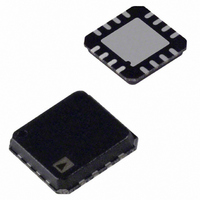ADA4855-3YCPZ-RL Analog Devices Inc, ADA4855-3YCPZ-RL Datasheet - Page 17

ADA4855-3YCPZ-RL
Manufacturer Part Number
ADA4855-3YCPZ-RL
Description
Triple High Speed Extend Input Range RR
Manufacturer
Analog Devices Inc
Datasheet
1.ADA4855-3YCPZ-R7.pdf
(20 pages)
Specifications of ADA4855-3YCPZ-RL
Amplifier Type
Voltage Feedback
Number Of Circuits
3
Output Type
Rail-to-Rail
Slew Rate
870 V/µs
-3db Bandwidth
410MHz
Current - Input Bias
3.8µA
Voltage - Input Offset
1300µV
Current - Supply
7.8mA
Current - Output / Channel
57mA
Voltage - Supply, Single/dual (±)
3 V ~ 5.5 V
Operating Temperature
-40°C ~ 105°C
Mounting Type
Surface Mount
Package / Case
16-LFCSP
Lead Free Status / RoHS Status
Lead free / RoHS Compliant
Gain Bandwidth Product
-
Lead Free Status / RoHS Status
Lead free / RoHS Compliant
SINGLE-SUPPLY OPERATION
The ADA4855-3 is designed for a single power supply. Figure 54
shows the schematic for a single 5 V supply video driver. The
input signal is ac-coupled into the amplifier via C1. Resistor R2
and Resistor R4 establish the input midsupply reference for the
amplifier. C5 prevents constant current from being drawn
through the gain set resistor. C6 is the output coupling capacitor.
For more information on ac-coupled single-supply operation of
op amps, see Avoiding Op-Amp Instability Problems in Single-
Supply Applications, Analog Dialogue, Volume 35, Number 2,
March-May, 2001, at www.analog.com.
Another way to configure the ADA4855-3 in single-supply
operation is dc-coupled. The common-mode input voltage can
go ~200 mV below ground, which makes it a true single-supply
amplifier. However, in video applications, the black level is set at
0 V, which means that the output of the amplifier must go to
ground level as well. The ADA4855-3 has a rail-to-rail output
that can swing to within 100 mV from either rail. Figure 55
shows the schematic for adding 50 mV dc offset to the input
signal so that the output is not clipped while still properly
terminating the input with 75 Ω.
V
IN
Figure 54. AC-Coupled, Single-Supply Video Driver Schematic
Figure 55. DC-Coupled, Single-Supply Video Driver Schematic
V
75Ω
5V
IN
R1
3.74kΩ
76.8Ω
R2
R1
50kΩ
22µF
5V
R2
C1
1kΩ
1kΩ
R3
R3
22µF
50kΩ
10µF
1µF
1kΩ
C2
R4
C5
C1
1kΩ
R5
R4
U1
5V
1kΩ
R6
–V
0.1µF
U1
C2
S
5V
0.01µF
–V
10µF
75Ω
C3
C4
R5
S
ADA4855-3
220µF
ADA4855-3
C6
R6
75Ω
75Ω
R7
V
OUT
R8
75Ω
V
OUT
Rev. 0 | Page 17 of 20
POWER SUPPLY BYPASSING
Careful attention must be paid to bypassing the power supply
pins of the ADA4855-3. High quality capacitors with low
equivalent series resistance (ESR), such as multilayer ceramic
capacitors (MLCCs), should be used to minimize supply voltage
ripple and power dissipation. A large, usually tantalum, 2.2 μF
to 47 μF capacitor located in close proximity to the ADA4855-3
is required to provide good decoupling for lower frequency
signals. The actual value is determined by the circuit transient
and frequency requirements. In addition, 0.1 μF MLCC decoupling
capacitors should be located as close to each of the power supply
pins and across both supplies as is physically possible, no more
than 1/8-inch away. The ground returns should terminate
immediately into the ground plane. Locating the bypass capacitor
return close to the load return minimizes ground loops and
improves performance.
LAYOUT
As is the case with all high speed applications, careful attention
to printed circuit board (PCB) layout details prevents associated
board parasitics from becoming problematic. The ADA4855-3
can operate at up to 410 MHz; therefore, proper RF design
techniques must be employed. The PCB should have a ground
plane covering all unused portions of the component side of the
board to provide a low impedance return path. Removing the
ground plane on all layers from the area near and under the
input and output pins reduces stray capacitance. Signal lines
connecting the feedback and gain resistors should be kept as short
as possible to minimize the inductance and stray capacitance
associated with these traces. Termination resistors and loads
should be located as close as possible to their respective inputs
and outputs. Input and output traces should be kept as far apart
as possible to minimize coupling (crosstalk) through the board.
Adherence to microstrip or stripline design techniques for long
signal traces (greater than 1 inch) is recommended. For more
information on high speed board layout, see A Practical Guide
to High-Speed Printed-Circuit-Board Layout, Analog Dialogue,
Volume 39, September 2005, at www.analog.com.
ADA4855-3














